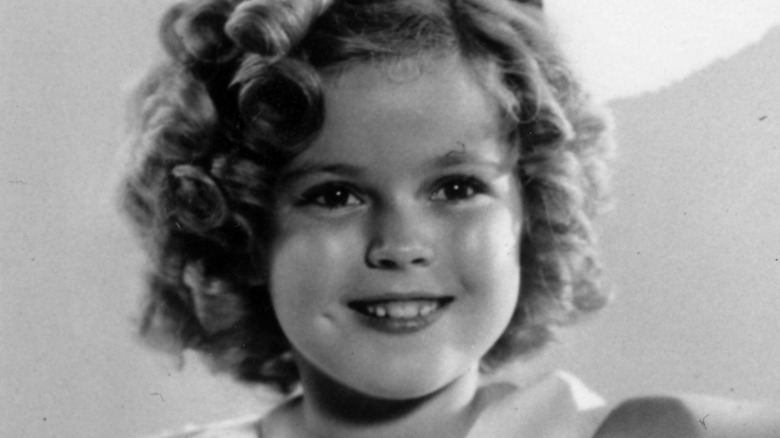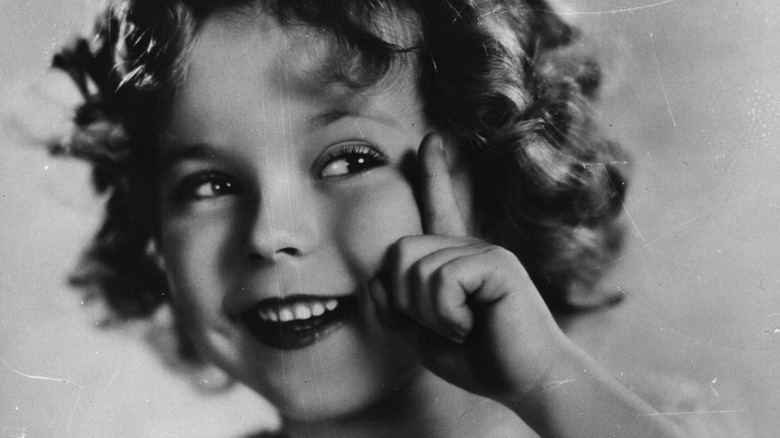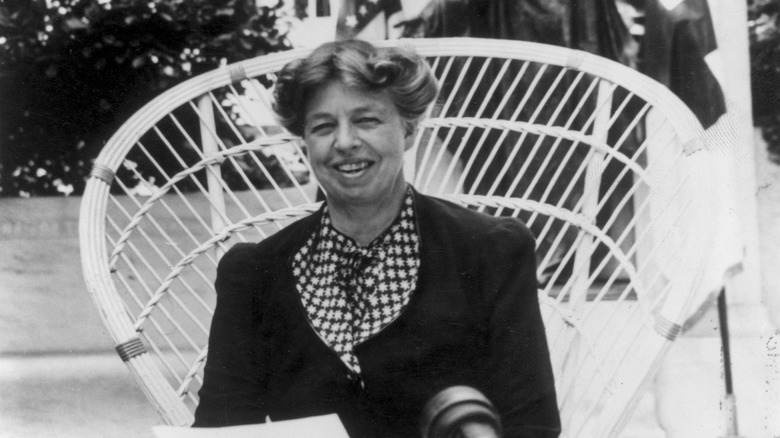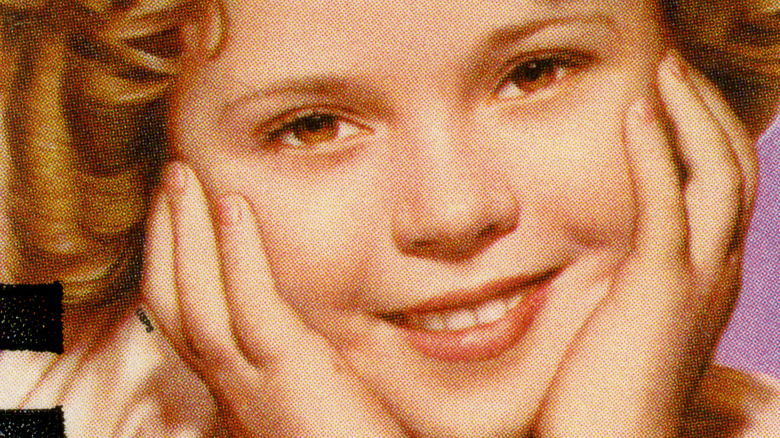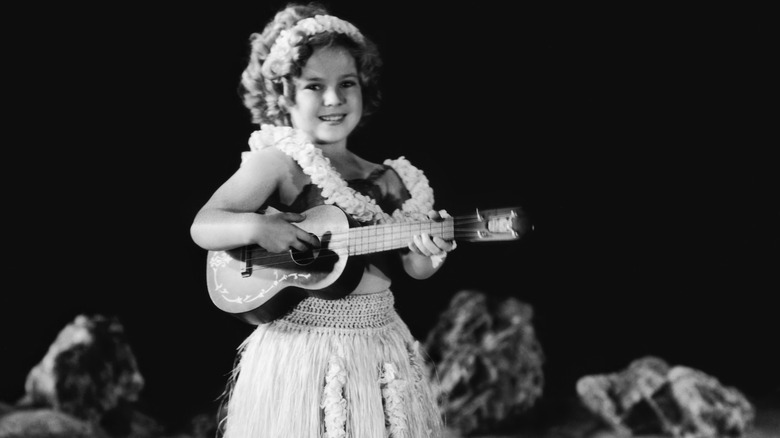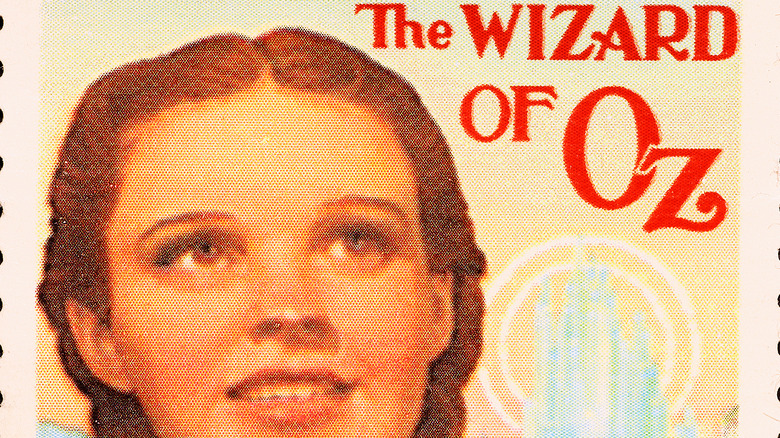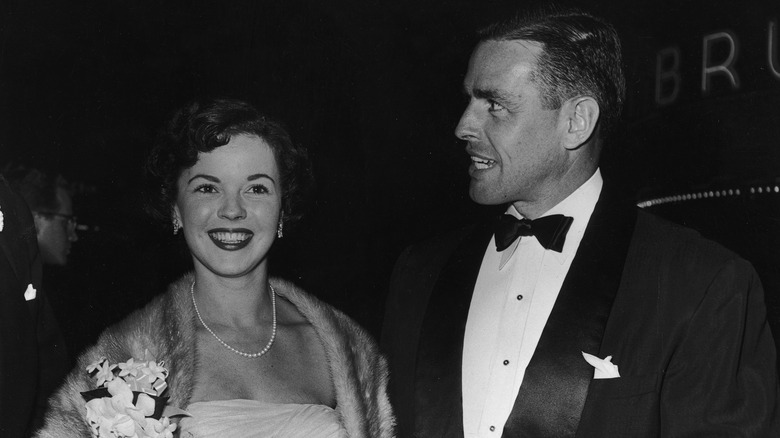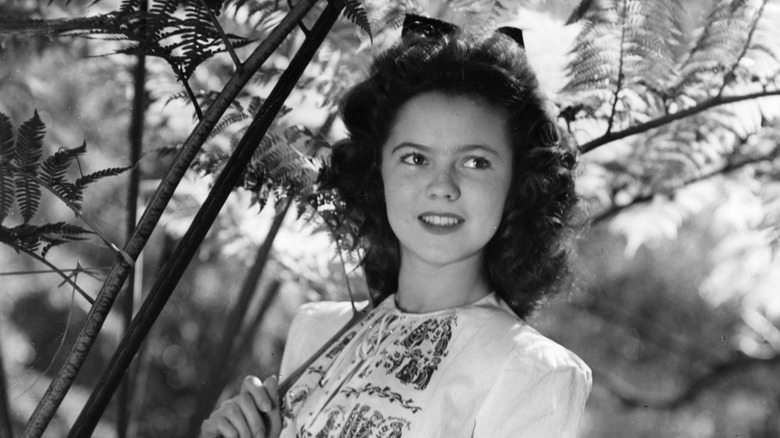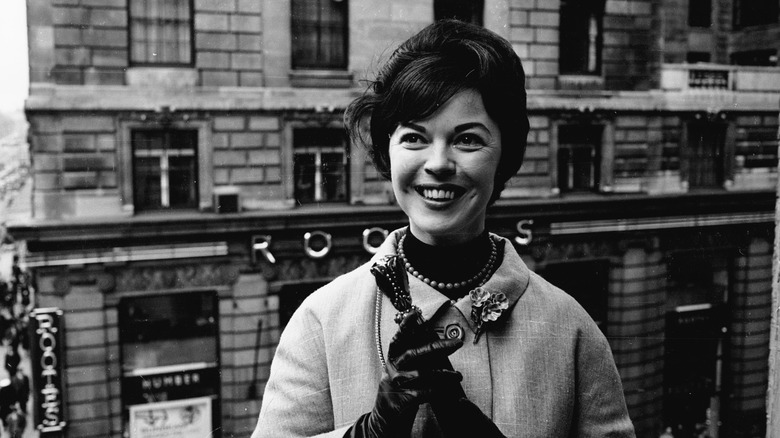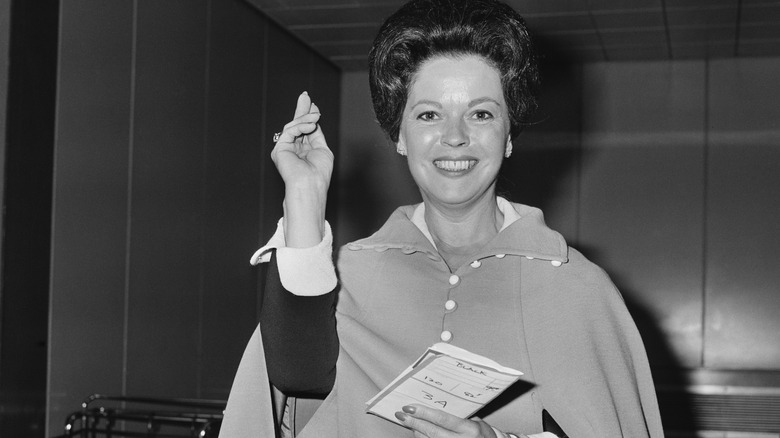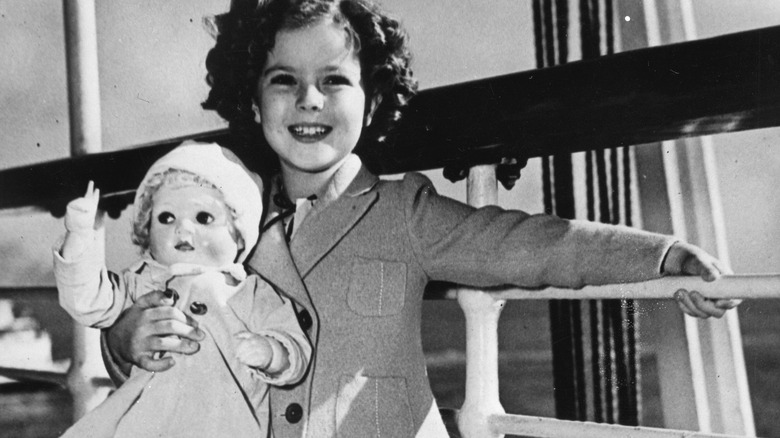What Fans Don't Know About Shirley Temple
We may receive a commission on purchases made from links.
Correction: An earlier version of this article misstated that no woman had ever been elected to Congress in the state of California prior to Shirley Temple's 1967 candidacy. Both Helen Gahagan Douglas and Florence Prag Kahn served prior to Temple's run.
When you hear the name Shirley Temple, you might think of an overly sweet mocktail you sipped when you were a kid, classic 20th-century films like "Bright Eyes," or songs like "On the Good Ship Lollipop." What you might not think of is a painfully failed marriage, a decades-long career spent in politics, a very public fight against breast cancer, and an overall rich and complex life that spanned from before the Great Depression to well into the second term of President Barack Obama.
Shirley Temple Black, originally Shirley Jane Temple, was born on April 23, 1928, in Santa Monica, California, and she would die, at age 85, on February 10, 2014, in Woodside, California, a few hours up the coast from where her life began (via Biography). During her decades alive, Temple touched tens of millions of lives thanks to her early years on the screen, and tens of thousands more thanks to her work as an ambassador and a businesswoman. She raised three children and remained married to her second husband, Charles Black, for 55 years until his death in 2005.
Temple could easily have withdrawn from public life while still a young woman and lived out her days in comfort. Instead, hers was a life with multiple chapters that, read as a whole, create as compelling a story as any movie in which she ever starred as a child. Here are 12 things you probably never knew about this superstar of a bygone time.
Shirley Temple was only a major box office draw for three years
Most people don't hit their stride in life until they are into their 30s, the decade by which the human brain is fully developed, according to Men's Health. At that point, the proverbial wild oats have been sown, and a career path is laid out or at least well-considered. Shirley Temple's life and career hit full gear a bit earlier than that, though. According to People, she was learning to dance by age 3, and by the time she turned 4, she was already appearing on the screen.
Temple's years of greatest success as a screen actress came between 1935 and 1938, when she was between the ages of 6 and 9 years old. The film "Bright Eyes," released in late December 1934, according to AFI, would rocket the young lady to international stardom, and for a while, she was a top box office draw and earner. By the time she was six, Temple was earning more than $1,000 a week for her work, a figure that today would be just under $20,000 weekly, according to the U.S. Inflation Calculator.
But by the end of 1938, her star was already fading, in the parlance of Hollywood. In 1940, when Temple was 11 years old, her contract with Fox studios was cancelled, and though the actress would still make pictures, her heyday had come and gone.
She shot Eleanor Roosevelt in the back with a slingshot
Despite being an absolute international superstar while a young child, Shirley Temple remained, of course, a child. Thus, she occasionally got herself into trouble as a result of an act of mischief. Perhaps the most notable such act that Temple later owned up to in her own memoirs was one that involved the First Lady of the United States of America. According to People, Temple, age 10, had been invited to a casual barbecue at Hyde Park, the residence of Franklin and Eleanor Roosevelt when they were away from the White House in Washington, D.C. Spotting an opportunity as Mrs. Roosevelt bent over to place some cuts of meat on the grill, Temple produced a slingshot, found a pebble, and fired it off, hitting the backside of the president's wife.
For this bit of indecency, Temple recalled receiving a spanking. In general, however, her relationship with her mother and father was warm, loving, and trusting, neither parent ever taking advantage of their child's stardom and never pushing her into roles or activities she did not herself embrace. (Her father did manage to squander much of his daughter's earnings, which he was supposed to be managing, but this was due to well-meaning ineptitude, not any sort of corruption or greed.)
Temple's hair had exactly 56 curls in every one of her childhood films
Shirley Temple's hair was styled in the exact same manner for almost every one of her films, especially those of her three-year high-water mark from 1935 to 1938. The hairdo had exactly 56 curls, each and every one painstakingly created by Temple's mother, Gertrude Temple, according to the Los Angeles Times. Her mother took on the role of stylist for Temple at the outset of the child's career and would stay on in that position for nearly every picture Shirley Temple starred in. According to Matchbook, Temple's hair was not actually all that curly, thus the use of those 56 curlers pinned in place before the night before every day of shooting.
Fans (or detractors, to be more accurate) often accused Temple of wearing a wig, with some people going so far as to grab and tug on the child's hair in an attempt to prove as much (via The List). The actress later said she wished her hair had been the result of a wig, as it would have spared her the many hours of discomfort that went into preparing her famous curly locks for each movie, but she confirmed that it was indeed her real hair. The actress' hair was a bright blond when she was young and slowly darkened over time as she grew older — whether Gertrude Temple delayed the visibility of this process with some peroxide is, however, unknown.
Temple starred in an impressive 43 feature films
Despite a career that was over before the age at which most of us have even held our first real job, Shirley Temple Black starred in an impressive 43 feature-length movies as well as 14 short films and 25 storybook movies, according to ShirleyTemple.com. (She also did some television work much later in life.) Perhaps even more impressive, and even a bit hard to believe, is the fact that by far, the bulk of her onscreen work was in the can, so to speak, by the time she was 10 years old.
Temple appeared in 29 feature films produced while she was between the ages of 3 and 10, therefore averaging about four films shot each year, yet she was featured in just 15 movies for the rest of her film-acting career, an output that dropped to average of between one and two movies per year.
Shirley Temple was slated to star in The Wizard of Oz
Were it not for her role as Dorothy in "The Wizard of Oz," generally hailed as one of the most successful movies ever made, the world might barely remember Judy Garland. Granted, Garland was already a popular actress of her time, but it was "Oz" that cemented her status as an icon that will surely be celebrated for as long as the popular media of our era is known. But legend has it that the role of Dorothy Gale almost didn't go to Garland — at one time, it was slated to be played by Shirley Temple.
According to ITV, the producers of "The Wizard of Oz" wanted the young Temple for the role of Dorothy, but 20th Century Fox would not let her work for MGM, and thus the filmmakers soon moved on to Judy Garland, who was about six years older than Temple, having been born in the summer of the year 1922 (via Judy Garland Museum). Decades later, two historians argued that Garland wasn't the back-up.
The irony is that Temple would be dropped by Fox, her contract cancelled, just a year after the movie was released in 1939. A starring role in "Oz" might have helped Temple transition from child actress to teenaged and ultimately more adult roles, but it was not to be.
Shirley Temple first married at age 17 and again in her early 20s
According to Biography, at the age of 17, Shirley Temple married a man named John Agar. Agar was seven years her senior, and at the time of their marriage, he was in the military and working as a physical fitness trainer, per The Guardian. Springboarding off his young wife's fame, Agar began an acting career (the couple did two films together) that, despite never achieving huge success, did see him appear in numerous movies and on television, according to Film Reference.
As a husband, Agar proved to be a train wreck. He was often drunk, voraciously flirted with other women, and was cold and uncaring to Temple. Sad and surprising as the details of her first short and tempestuous marriage were, of even more surprise might be the steadiness of her second, often a rarity for those steeped in Hollywood. What makes the five-and-a-half-decade second marriage of Temple all the more impressive is the fast way it started.
Shirley Temple divorced John Agar in 1949 and would meet Charles Black soon after. The couple would become engaged within less than two weeks of first meeting and married within less than a year. The marriage lasted until Charles Black's death in the year 2005.
Shirley Temple retired from acting at the age of 22
There's a reason you only think of Shirley Temple as a child star: She was. While some actors and actresses manage to keep a career going as they grow from youth into adulthood (think of Daniel Radcliffe of the "Harry Potter" film franchise for one fine example), others have a career fizzle as they grow up. Temple may well have had a so-called second act as an grown woman, but she didn't want to. Granted, she was getting fewer and fewer roles as she grew, but for her, it wasn't a matter of fading away. Temple officially retired from acting at the age of 22, according to Biography.
This was but the end of one career that had started amazingly early — it was hardly the end of her life story. Already mother to one child by 22, soon divorced and remarried and eventually with three children in all, Temple would go on to a life spent in business and national and international politics, and it was her life in public service on which she looked back with the most pride, calling the "personal rewards" great. Temple earned awards and an honorary rank in the U.S. Foreign Service for her work.
Shirley Temple ran for Congress in California
In 1967, in her late 30s, Shirley Temple Black, who'd come a long way from her days as child star on the silver screen, ran for Congress, according to USA Today. She lost, but that's hardly a surprise, even given her powerful name recognition. She well understood the role her gender played in the process of her campaigning and how it was an obstacle to winning a seat, saying in one interview at the time: "I think men are fine and here to stay but I have a hunch that it wouldn't hurt to have a woman's viewpoint expressed in that delegation of 38 men. One congresswoman among 38 congressmen is not unfair, fellows."
Temple Black ran for a Republican seat (she declared herself to be a "Republican Independent"), and despite her loss, she would soon embark on a long and meaningful career in politics, one in which she served primarily under Republican presidential administrations. The former child star was well-aware that her childhood fame was an asset and never hid from her past, saying, according to Newsweek: "Shirley Temple opened doors for Shirley Temple Black."
Shirley Temple served as the U.S. ambassador to two countries
Shirley Temple served as the ambassador to two countries, and we don't mean ceremonially: She was the official ambassador of the United States of America, and she proved herself an adroit political operator and a serious asset to the U.S. government. Already well-travelled and worldly, having experienced such events as the so-called Prague Spring in 1968 firsthand, according to Newsweek, Shirley Temple Black was named the U.S. ambassador to Ghana by President Gerald Ford in 1974. Her tenure in this post involved helping the Ghanaian government manage and maintain its valuable resources.
Temple Black's next ambassadorship came when President George H.W. Bush appointed her the U.S. ambassador to Czechoslovakia in the year 1989. During her time in that role, the Soviet hold over that nation finally ended, and two new states was born, the democratically governed Czech Republic (today known as Czechia) and Slovakia, reports The New York Times. Of her work in diplomacy in Eastern Europe, another former ambassador, Norman Eisen said: "[F]rom her earliest age, she was a prodigy in her confidence and her ability to take command of any situation. She awed her costars with that quality on the set, and the same was true on the stage of world affairs, as the eyes of the world looked to what was then Czechoslovakia."
She is credited with removing some of the stigma for talking openly about breast cancer
Shirley Temple Black overcame breast cancer in the early 1970s, an era in which open discussion of cancer, and especially of breast cancer, was quite rare, according to MDedge. Hardly ashamed of her plight and determined to empower other women to feel the same, in 1973, Temple Black went public with her diagnosis and treatment. Her openness about her illness may seem unremarkable now, but according to none other than the National Breast Cancer Foundation: "She is considered one of the first public figures to share her condition with the media, launching a series of similar revelations by other notable women, including Betty Ford, Nancy Reagan, Sheryl Crow, and Robin Roberts."
And public about it she certainly was: While in the hospital recovering from her mastectomy, Temple Black allowed photographers into the room and spoke to reporters about her condition and her experiences. She would go on to encourage women to conduct regular self-exams, to seek treatments they felt they needed, and to advocate for themselves. Her most famous quote emerging from her experience with cancer was, according to Groovy History: "The doctor can make the incision, I'll make the decision."
The first Shirley Temple drink was apparently made for Temple herself
Arguably the most famous nonalcoholic cocktail (or mocktail, in modern parlance) on Earth, the Shirley Temple was, of course, named for the young actress. And not in honor of her, but actually for her: As the story goes, according to 7UP, the drink was concocted by a bartender who felt bad to see the little movie star sitting among adults enjoying their fancy drinks and thus decided to whip up a booze-free concoction she could sip herself. It's unclear if the provenance of the drink was the restaurant Chasen's in West Hollywood or the famed Brown Derby, but regardless, Temple herself was both proud the drink existed (via NPR) yet not a fan of it herself, calling it "too sweet" (via The List).
There are two generally accepted ways to make a Shirley Temple: The first is to mix a quarter cup of 7UP with a half tablespoon of grenadine and to serve that over ice with maraschino cherries and an orange peel for a garnish. In other recipes, ginger ale is used as the base soda. Adding a shot of a white liquor makes the drink a Dirty Shirley, while adding a dark rum makes it a Shirley Temple Black, cleverly enough.
Shirley Temple dolls are valuable today
According to PBS' "Antiques Roadshow," an original Shirley Temple doll from the mid-1930s is today worth hundreds of dollars if in good condition. One may fetch $650, in fact, and many in varied condition can be found on eBay and other sites these days. The curly-haired dolls were quite common during the heyday of Temple's career, and the actress was often pictured holding one herself.
Even well into her advanced years, Shirley Temple Black herself was often reminded of the existence of the dolls. According to People, she once said: "And very often women say, 'Do youuuuuu know what I have?' and I want to say, 'Yessssssss, I do.' Because inevitably the answer is, 'An original Shirley Temple doll.'"
Hardly annoyed by such encounters, she deeply appreciated her lasting fan recognition and affection, saying: "I've been so blessed. If someone asked me whom I would choose to be if I could come back in another life, I would have to say Shirley Temple Black. I cannot think of a more interesting life to ask for."
